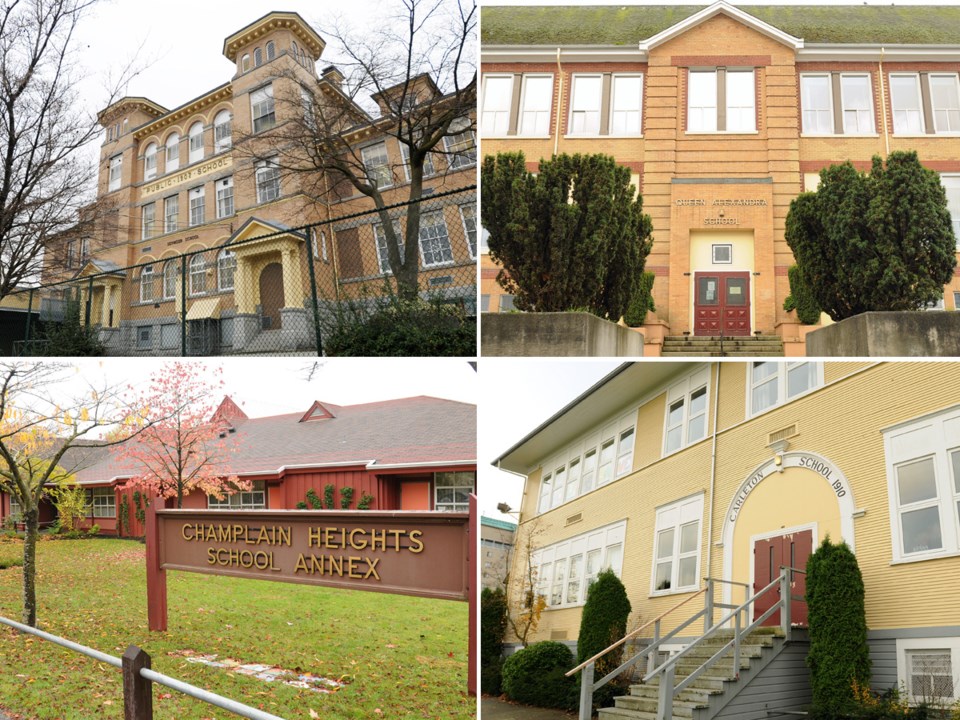In a bid to get more students into seismically safe schools, save money on maintenance and free up other money for capital projects, staff at the Vancouver School Board have reopened the school closure debate.
In a draft long-range facilities plan released to the public on Friday, Feb. 22, VSB includes an analysis of 28 schools at high risk in an earthquake that have low enrolment. Those schools are not formally being recommended for closure, but they have been identified as possibilities.
It’s all about getting students into safe schools as quickly as possible, said VSB secretary-treasurer David Green.
“The challenge is that you have declining enrolment and excess capacity,” Green said. “Not all of our schools will probably be seismically upgraded because we have too much capacity.”
The last time this topic was before the school board, in 2016 under the former Liberal government, tensions were high, to say the least. Trustees ended up getting fired by the province and several senior staff members went on medical leaves after a contentious public meeting.
It was always inevitable the topic would rear its head again before too long — the VSB has more than 10,000 empty seats in its schools, a number that is projected to grow in the next eight years to 12,000 or even 17,000 if new schools are built. That excess room is mostly found in old, dilapidated schools that are not safe if an earthquake hits and that need millions of dollars in maintenance.
Schools that qualify for seismic upgrading are funded at the “lowest cost option,” which causes bizarre situations like that at the 98-year-old Cavell elementary where the province will pay $15.6 million to upgrade the school, while ignoring maintenance issues and a required expansion, but won’t pay $21.2 million for a new school, even though that would save $2.5 million over the coming decades.
The new draft plan is designed to address those problems, by closing some schools and developing a strategy to sell off some parts of the district’s $7.6 billion in land and buildings.
The complex, 179-page report takes each of those 28 identified schools and calculates whether there would be enough room in the surrounding schools if that school closes. In all but five, projections to 2027 show there would be enough space.
Some of the schools analyzed in the report will be familiar to readers — many of them, such as Bruce, Queen Alexandra, Carleton, Seymour elementary schools and McBride and Champlain Heights annexes, were also considered for closure in 2010 and again in 2016.
Others were also on the chopping block in 2016, including Britannia and Gladstone secondaries, Tecumseh annex, and Dr. A.R. Lord elementary. Still others are entirely new to the list, such as Renfrew, Nootka, Grenfell, Thunderbird, Franklin, MacCorkindale, Champlain Heights, Mackenzie, Henderson, Cunningham and Grandview elementary schools, Windermere secondary and Tillicum annex.
Not all of these schools could close — since all of them are on the city’s east side, many of them are adjacent to each other. A few schools on the west side were also analyzed — Prince of Wales and Point Grey secondaries and Queen Elizabeth elementary — but the study found there would not be enough room in nearby schools if any of those schools were closed.
Cross boundary student numbers were included in projected enrolments, VSB communications said in an email.
There’s a long way to go yet before any school closes. First, there are several meetings to get feedback over the next couple of weeks. The Ministry of Education, which plays a pivotal role in funding seismic upgrades and new schools, also must concur with the report, something Green believes will happen.
“There is always back and forth between the ministry and the VSB about our long-range facilities plan,” Green said. “Having students in safe seats is one of the ministry’s primary objectives.”
The board will vote on the draft plan in April. If it’s approved, a list of schools that would proceed to the formal consideration for closure would be created by the end of September.
There is then a process for public consultation before the board makes a final decision. In any case, no schools will close before the start of the 2020-2021 school year, Green said.
The draft plan includes the notion of creating workforce housing for teachers on some school properties, as well as hiring real estate consultants to develop a plan to generate money. The board has a policy against selling entire school sites, but can sell portions of sites, Green said.
If the board had its own capital, it could avoid issues like those that have arisen about the Cavell upgrade or the Hamber replacement.
“These should be relatively simple decisions that a board could make if they had sufficient funds to contribute to projects,” Green said. “The only way we can do that is if we dispose of portions of sites or do something with Kingsgate Mall. I’m a strong believer that that’s the direction the board should go.”
The VSB is between a rock and a hard place on this one — the province will only fund seismic upgrades for the number of students actually attending schools in the district. It’s not going to pay to make empty seats safe. Without a doubt, the process is going to be difficult, divisive and contentious, but if it’s done properly, it will pay off in safer, more functional schools.
Comments on the plan can be sent to lrfp@vsb.bc.ca.



